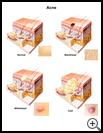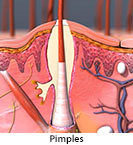
Acne: Teen Version
What is acne?
Acne is a skin condition that occurs when the oil glands in your skin are clogged and become inflamed or infected. More than 90% of teenagers have some acne.
With acne you will probably have:
- Whiteheads, which are closed plugged oil glands
- Blackheads, which are open plugged oil glands (the oil turns black when it is exposed to air)
- Red bumps, which are inflamed oil glands (the larger red bumps are quite painful)
Acne usually appears on your face, neck, and shoulders.
What causes acne?
Acne is due to an overactivity and plugging of the oil glands. The main cause of acne is an increased level of hormones during adolescence. Heredity also plays an important role.
Acne is not caused by diet. A person who has acne does not have to avoid eating fried foods, chocolate, or any other food.
Acne is not caused by sexual activity. It is not caused by dirt or by not washing your face often enough.
How long does it last?
New whiteheads usually stop appearing after 4 to 6 weeks of treatment. You will probably need to continue the treatment for several years.
Acne usually lasts until age 20 or even 25. Do not worry about scarring. It is rare for acne to leave scars.
How is it treated?
There is no medicine at this time that will cure acne. However, good skin care can keep acne under control and at a mild level.
Basic treatment for all acne
- Wash your skin twice a day and after exercise. The most important time to wash is bedtime. Use a mild soap such as Dove.
- Shampoo your hair daily. Pull your hair away from your face. Long hair can make acne worse by rubbing against your skin.
- Avoid picking and squeezing. Picking stops acne from healing. Squeezing causes bleeding into the skin and blotches that can last a month.
- Avoid scrubbing your skin or using abrasive soaps. Hard scrubbing of the skin is harmful because it irritates the openings of the oil glands and can cause them to be more tightly closed.
- Avoid putting any oily or greasy substances on your face. Oily and greasy substances make acne worse by blocking oil glands. If you use cosmetics, use water-based cosmetics and wash them off at bedtime. Look for make-up, cosmetics, and skin care products with the word noncomedogenic on the label. This means that it does not cause or worsen acne.
- Avoid hair tonics or hair creams (especially greasy ones). When you sweat, these substances will spread to your face and aggravate the acne.
- If you are using acne medicine, don't stop using the medicine too soon. It takes 8 weeks to see a good response.
Treatment for whiteheads
Whiteheads should be treated with the following:
- Benzoyl peroxide 5% lotion or gel
This lotion helps to open pimples and unplug blackheads. It also kills bacteria. It is available without a prescription. Ask your pharmacist to recommend a brand.
Apply the lotion once a day at bedtime. Redheads and blonds should apply it every other day for the first 2 weeks.
An amount of lotion the size of a pea should be enough to cover most of your face. If your skin becomes red or peels, you are using too much of the medicine or applying it too often. Try using less of it or applying it less often. You may need to use this lotion for several years.
Caution: Benzoyl peroxide bleaches clothing, carpets, etc. Apply it only at bedtime and put it on sparingly.
- Pimple opening
In general, it is better not to "pop" pimples, but most teenagers do it anyway. Therefore, do it safely. Never open a pimple before it has come to a head. Wash your face and hands first. Use a sterile needle (sterilized by alcohol or a flame). Nick the surface of the yellow pimple with the tip of the needle. The pus should run out without squeezing. Wipe away the pus and wash the area with soap and water.
Scarring will not result from opening small pimples, but it can result from squeezing boils or other large, red, tender bumps.
Treatment for blackheads
Blackheads should be treated with the following:
- Benzoyl peroxide 5% lotion or gel
This lotion is also excellent for removing thickened skin that blocks the openings to oil glands. Use the lotion as described above for whiteheads.
- Blackhead extractor
Blackheads that are a cosmetic problem can sometimes be removed with a blackhead extractor. This instrument costs about a dollar and is available at any drugstore. By placing the hole in the end of the small metal spoon directly over the blackhead, you can apply uniform pressure that does not hurt normal skin. This method is much more efficient than anything you can do with your fingers. Soak your face with a warm washcloth before you try to remove blackheads. If the blackhead does not come out the first time, leave it alone.
Treatment for red bumps
Large red bumps mean the infection has spread beyond the oil gland. If you have several red bumps, you probably also need an antibiotic. Antibiotics come as solutions for the skin or as pills.
If you still have problems with acne, talk with your healthcare provider about prescription medicines such as retinoids or hormone pills, or other possible treatments.
When should I call my healthcare provider?
Call during office hours if:
- The acne has not improved after you have treated it with benzoyl peroxide for 2 months.
- It looks infected (large, red, tender bumps).
- You have other concerns or questions.
Last modified: 2012-11-08
Last reviewed: 2017-06-05


